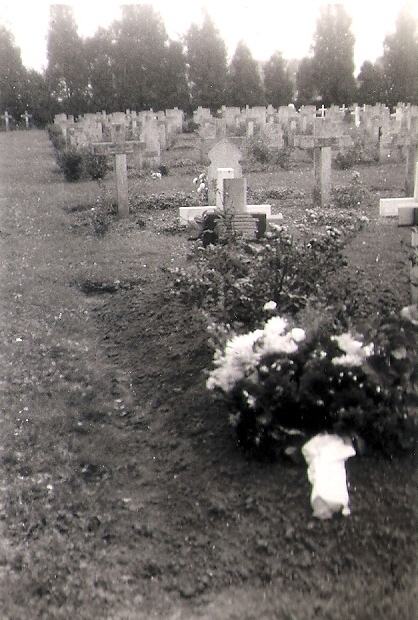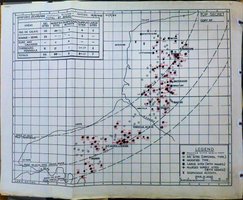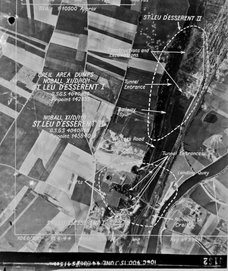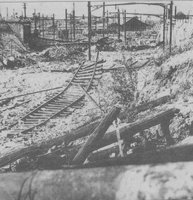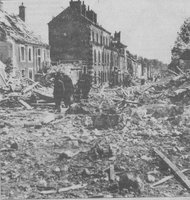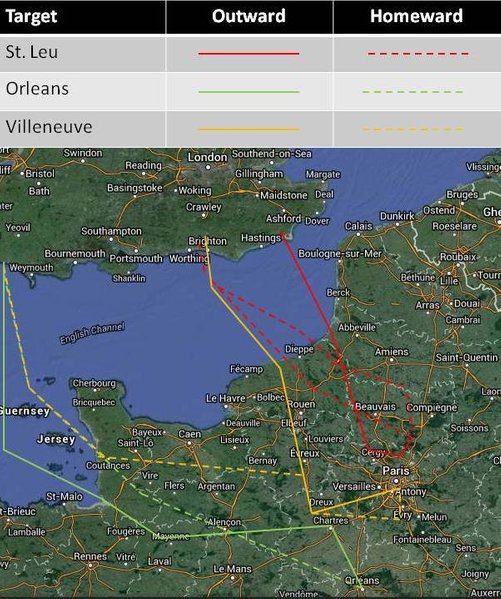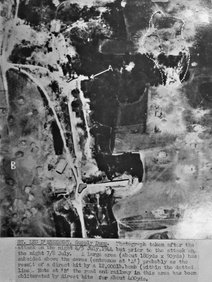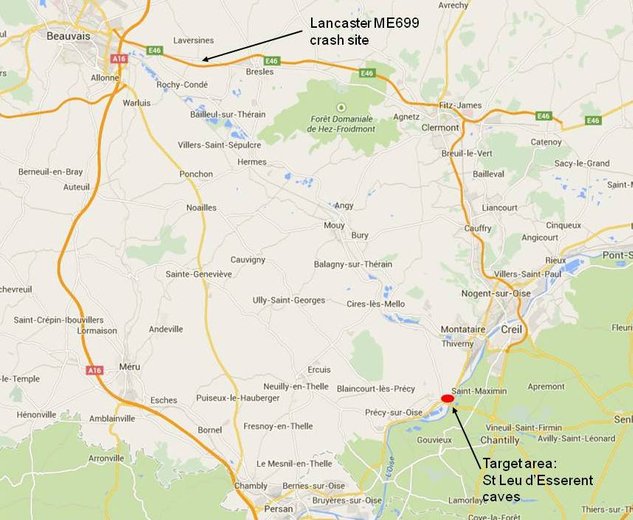Lancaster ME699 - A Bomber crew at war
Raid on St Leu d'Esserent 4th/5th July 1944
The raid on the V1 storage and assembly areas in the caves at St Leu d'Esserent, near Criel, north of Paris, on the 4th/5th of July 1944 was the first of three by Bomber Command as the USAAF and RAF attempted to stem the attacks on southern England by the V1 rocket, or Doodlebug as it became known.
The V1 Menace
The Allies had been aware of the potential threat from V1 flying bombs at England since mid 1943, with the codename of the operation against them being called Operation Crossbow. They had delayed the development of the Germans "Vengence" weapon (V1 and V2) program with tactical raids starting with the attack by Bomber Command on the research station at Peenemunde in August 1943, which is estimated to have put the program back by three to six months.
Further delays were caused by attacks on so called "ski sites" in northern France which had storage buildings that were curved at the end like snow skis. These were large and obvious enough to target and as a result the Germans switched tactics to build smaller, easily built and better hidden launching ramps that were much harder to attack with the heavy bomber force. The further time involved in this change of tactics resulted in the start of V1 launches being delayed until after D-Day.
Once the weapons were being launched at England, from the night of the 12th/13th June 1944, it became a political priority to counter the threat even though the heavy bombers were not really suited to the task in hand. A contemporary US newpaper report on the early V1 attacks is here.
Many V1s failed to reach their target through malfunction, or the flak, balloon and fighter defences in southern England, but many did get through, causing death and destruction in London and surrounding areas.
People who witnessed the attacks report that the approach of a "dooblebug" was a terrifying experience, beginning with the tell tale unmistakable sound of it's engine approaching. People hoped that the noise continued though, as when the engine cut out, the bomb would fall out of the air and explode. Where they fell was totally random.
In total 6,184 civilians were killed, 17,981 were seriously injured and 23,000 homes destroyed by V1s, with approximately another million homes damaged. There were about 9,000 launched in total, 6,725 of which were "observed" over the UK, the rest having failed to make it over the channel. 3,463 were destroyed by fighter, gun and balloon defences.
By the end of June 1944 the Germans were launching over 200 of the bombs a day at southern England from various sites scattered across northern France. The RAF carried out many raids on specific launch sites but these were very hard to hit and destroy with such a blunt weapon as a heavy bomber. It became clear that there must be a central assembly and storage area where the bombs were being supplied to the launch sites from.
"Leopold"
The Special Operations Executive (SOE) submitted a report suggesting that the natural limestone caves in St Leu d'Esserent were being used for V1 storage and assembly in March 1944, but it wasn't until June that further intelligence pointed to the site and the caves, which had previously been used for growing mushrooms, were targeted.
On the 29th June the Germans launched the 2,000th V1 at England in what was seen more and more as a dangerous campaign both in terms of the threat to the civilian population of southern England and in terms of propaganda value to boost the morale of the hard pressed Germans following the invasion on D-Day and the continuing strategic Allied bombing campaign.
The first raids on the caves at St Leu d'Esserent, codenamed by the Germans "Leopold", were by American daylight forces in late June. These caused minimal damage but further intelligence gleaned in intercepted communications resulting from the raid confirmed that the site was a significant base for V1's and the site was set as a target for a major raid by the RAF's 5 Group on the night of the 4th/5th July.
4th/5th July 1944
Steve Darlow describes the mission that night in some detail in chapter 10 of his excellent book on the battle against the V1 menace, "Sledgehammers for Tintacks". The details that follow are taken from that book, published by Grub Street.
The difficulty of finding the target meant that a night with good visibility was chosen, with a bright moon and clear skies forecast. This would mean that the German night fighter forces would be a problem if they intercepted the bomber stream.
As a result. the raid was planned to provide maximum deception for the main force with diversionary raids on railway junctions at Villeneuve and Orleans in an attempt to draw off the night fighter force.
The raid proper on the caves at St Leu d'Esserent was led by the famous Dambusters, 617 Squadron, who would attack with 12,000lb "Tallboy" bombs to try to collapse the caves followed immediately by the main force to bomb the area with 1,000lb bombs.
The diary section at the RAF Bomber Command History site records that "246 aircraft made the main attack, with 19 aircraft from 617 Squadron making a separate initial sortie on the target with specialist bombs."
At 01:30 Wing Commander Leonard Cheshire leading 617 Squadron in a Mustang marked the target for the rest of the squadron. 11 Tallboys were dropped with the remainder of the squadron unable to see the target accurately due to smoke, with the main force attacking with high explosive bombs almost immediately afterwards.
Thirteen aircraft failed to return from the mission (5.3% - above average losses even then), one of them my dad's 44 Squadron Lancaster, KM-T. T for Tommy was by then a veteran of famous missions such as Nuremberg, Schweinfurt, Mailly le Camps and Wesserling, but in the end fell to a night fighter over Beauvais.
Of the losses that night Bomber Command put eight down to fighters, two to flak and one to flak and fighters. The remaining two were lost to unknown causes.
In all seventy-seven men died in the raid with eight more taken as POW's. Nine men evaded capture. My Father was one of the nine.
Fourteen more Lancasters were lost in the diversionary raids on Villeneuve and Orleans and seventeen German aircraft were shot down in return on that night by bombers defending themselves and "Intruder" missions by Allied fighter bombers.
"You will keep going back"
The importance of the target, as indicated in intercepted German communications on the disruption to V1 operations caused by the first night raid, and obvious efforts by the Germans to repair the site, meant that the RAF would return to St Leu d'Esserent twice more in July and August with the loss of a further thirty-two aircraft. Crews were told in briefings that they would keep going back until the target was destroyed.
The raid on the 7th/8th July was one of the fiercest night time air battles over France in World War II with thirty-one RAF aircraft lost out of 221 sent, 14% of the force. The losses occurred after the various strategies to deceive the defending night fighters failed, and the German controllers had their forces in just the right place at the right time to intercept the St Leu force on a night with good visibility due to the near full moon.
In contrast on August 5th, out of 742 aircraft that attacked St Leu d'Esserent and another storage site at Forêt de Nieppe, just one aircraft was lost.
By the end of August the town of St Leu d'Esserent itself was 85% destroyed in the various raids before the site was finally rendered totally unusable.
Was it worth it?
Air Chief Marshall Harris was less than convinced throughout that the campaign against the flying bomb threat was a good use of his forces, and certainly Steve Darlow in "Sledgehammers for Tintacks" concludes that the many attacks on the various types of launching sites across northern France had little effect on the numbers fired.
Total losses for Bomber Command against Crossbow targets (excluding Peenemunde) were 213 aircraft and 1,481 aircrew. The total tonnage of bombs dropped on Crossbow targets exceeded the total dropped on Berlin in the whole of the war.
Darlow does show statistically that the attacks on the larger targets, "Leopold" at St Leu and a similar site at Nucourt ("Norbert") reduced the total number of V1s that were launched by around 1,000 in total and suggests that the reduction in the number of rockets that could be launched on a daily basis after the raids on thse sites significantly increased the ability of the defenders in the UK to bring a growing proportion of the remaining ones down.
By the end of the summer of 1944 the battle against the V1 was just about over, partly due to the efforts of the bombers but finally as a result of the advance of ground forces following the breakout from Normandy, and the final Crossbow operation by Bomber Command took place on 3rd September 1944.
St Leu d'Esserent today
Graham Taylor, an Englishman living in France for the last 11 years, is pulling together information on the V1 Storage area at St Leu d'Esserent. His site is under development but contains some great pictures and can be found here. He is also trying to set up a museum to record the history of the V1 at St Leu.
In 2004 a group from the 207 Squadron Association visited St Leu d'Esserent and the caves. 207 Squadron lost two aircraft on the raid on the 4th-5th July. The story of their visit can be found here. Photographs of the caves, which have now been returned to their previous use for growing mushrooms are here.









